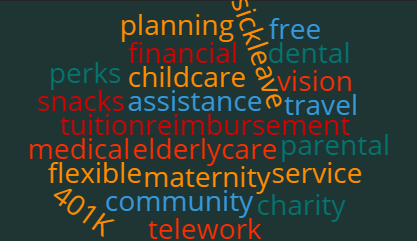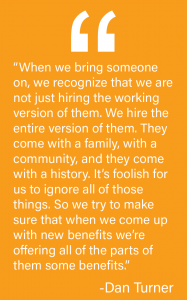
Good news: The economy is getting better. As of November 2016, unemployment is down to 4.6% nationwide, and 3.7% in the DC metro area – where it was before the Great Recession. This also means that job candidates can be more selective in where they choose to work. So how can companies and agencies continue to attract our industry’s best talent?
In the most recent Employee Job Satisfaction and Engagement survey conducted by the Society for Human Resource Management (SHRM), benefits are the third most important measure of job satisfaction among study respondents, trailing just behind respect among colleagues and compensation. Benefits have been among the top five indicators of job satisfaction since 2002, with the exception of 2012. Consequently, benefits (or lack of them) are the second highest reason people leave their job according to the survey.
Realizing this, more and more companies are seeking out-of-the-box or “soft-benefits” to offer employees to make themselves more desirable as an employer. This goes beyond medical, dental, vision, and 401K, which are considered standard offerings. Soft-benefits are the perks to working for a company, such as flexible working arrangements, wellness programs, tuition reimbursement, and similar perks – benefits that help real people living in the real world.
Demographic changes have increased the demand for flexible working arrangements. Millennials who are just starting their families may need time for their children, while Gen Xers and Boomers may need to care for aging parents. Whether businesses realize it or not, life happens between 9 a.m. and 5 p.m., which means employees can’t always produce during these hours. Flexibility allows workers to still produce and be accountable for their work, while attending to the personal needs that might otherwise prevent them working at all.
In the 2016 Strategic Benefits Survey, SHRM found that of the surveyed companies that offered wellness benefits (gym memberships, smoking cessation help, preventative health screenings, etc.), 40% said their wellness initiatives decreased unplanned absences, and one-third cited a direct increase in productivity.
 TCG President Dan Turner offers his perspective on benefits: “When we bring someone on, we recognize that we are not just hiring the working version of them. We hire the entire version of them. They come with a family, with a community, and they come with a history. It’s foolish for us to ignore all of those things. So we try to make sure that when we come up with new benefits we’re offering all of the parts of them some benefits.”
TCG President Dan Turner offers his perspective on benefits: “When we bring someone on, we recognize that we are not just hiring the working version of them. We hire the entire version of them. They come with a family, with a community, and they come with a history. It’s foolish for us to ignore all of those things. So we try to make sure that when we come up with new benefits we’re offering all of the parts of them some benefits.”
TCG has taken a similar approach to hard and soft-benefits. The hard benefits like appropriate compensation, leave time, and retirement accounts are augmented with soft-benefits. This includes virtual concierge service that staff are only allowed to use for personal errands, emergency home care for children and the elderly, annual training budgets that can roll over from year to year, free tickets to theater and sporting events, wellness initiatives, and flexible working arrangements. More than 70% of TCGers work from home one or more days per week, and more than 50% work from home every day.
We’ve found this approach to be effective at TCG. Based on employee surveys, TCG has been recognized by Fortune, The Washington Post, Washington Business Journal, and Entrepreneur as a great place to work, offering great benefits and maintaining a positive company culture. Turnover at TCG is well below the national average, and an employee survey revealed that 99% of TCGers are proud to tell others they work at TCG.
Benefits, hard and soft, are not and will never be the sole determining factor in employee satisfaction. But these investments in staff go a long way in strengthening a workforce.